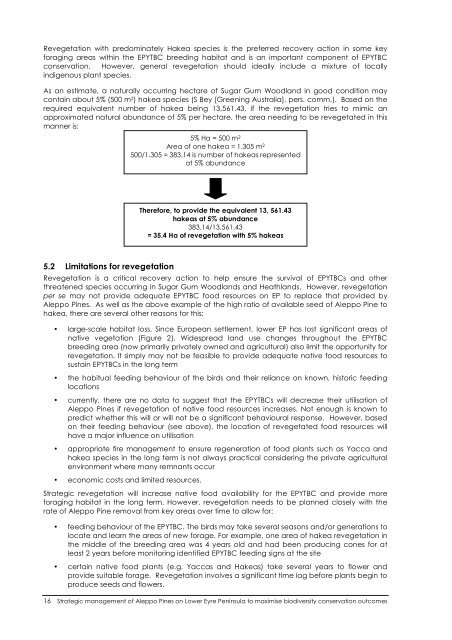Strategic management of Aleppo Pines on Lower Eyre
Strategic management of Aleppo Pines on Lower Eyre
Strategic management of Aleppo Pines on Lower Eyre
Create successful ePaper yourself
Turn your PDF publications into a flip-book with our unique Google optimized e-Paper software.
Revegetati<strong>on</strong> with predominately Hakea species is the preferred recovery acti<strong>on</strong> in some key<br />
foraging areas within the EPYTBC breeding habitat and is an important comp<strong>on</strong>ent <str<strong>on</strong>g>of</str<strong>on</strong>g> EPYTBC<br />
c<strong>on</strong>servati<strong>on</strong>. However, general revegetati<strong>on</strong> should ideally include a mixture <str<strong>on</strong>g>of</str<strong>on</strong>g> locally<br />
indigenous plant species.<br />
As an estimate, a naturally occurring hectare <str<strong>on</strong>g>of</str<strong>on</strong>g> Sugar Gum Woodland in good c<strong>on</strong>diti<strong>on</strong> may<br />
c<strong>on</strong>tain about 5% (500 m 2 ) hakea species (S Bey [Greening Australia], pers. comm.). Based <strong>on</strong> the<br />
required equivalent number <str<strong>on</strong>g>of</str<strong>on</strong>g> hakea being 13,561.43, if the revegetati<strong>on</strong> tries to mimic an<br />
approximated natural abundance <str<strong>on</strong>g>of</str<strong>on</strong>g> 5% per hectare, the area needing to be revegetated in this<br />
manner is:<br />
5% Ha = 500 m 2<br />
Area <str<strong>on</strong>g>of</str<strong>on</strong>g> <strong>on</strong>e hakea = 1.305 m 2<br />
500/1.305 = 383.14 is number <str<strong>on</strong>g>of</str<strong>on</strong>g> hakeas represented<br />
at 5% abundance<br />
Therefore, to provide the equivalent 13, 561.43<br />
hakeas at 5% abundance<br />
383.14/13,561.43<br />
= 35.4 Ha <str<strong>on</strong>g>of</str<strong>on</strong>g> revegetati<strong>on</strong> with 5% hakeas<br />
5.2 Limitati<strong>on</strong>s for revegetati<strong>on</strong><br />
Revegetati<strong>on</strong> is a critical recovery acti<strong>on</strong> to help ensure the survival <str<strong>on</strong>g>of</str<strong>on</strong>g> EPYTBCs and other<br />
threatened species occurring in Sugar Gum Woodlands and Heathlands. However, revegetati<strong>on</strong><br />
per se may not provide adequate EPYTBC food resources <strong>on</strong> EP to replace that provided by<br />
<str<strong>on</strong>g>Aleppo</str<strong>on</strong>g> <str<strong>on</strong>g>Pines</str<strong>on</strong>g>. As well as the above example <str<strong>on</strong>g>of</str<strong>on</strong>g> the high ratio <str<strong>on</strong>g>of</str<strong>on</strong>g> available seed <str<strong>on</strong>g>of</str<strong>on</strong>g> <str<strong>on</strong>g>Aleppo</str<strong>on</strong>g> Pine to<br />
hakea, there are several other reas<strong>on</strong>s for this:<br />
• large-scale habitat loss. Since European settlement, lower EP has lost significant areas <str<strong>on</strong>g>of</str<strong>on</strong>g><br />
native vegetati<strong>on</strong> (Figure 2). Widespread land use changes throughout the EPYTBC<br />
breeding area (now primarily privately owned and agricultural) also limit the opportunity for<br />
revegetati<strong>on</strong>. It simply may not be feasible to provide adequate native food resources to<br />
sustain EPYTBCs in the l<strong>on</strong>g term<br />
• the habitual feeding behaviour <str<strong>on</strong>g>of</str<strong>on</strong>g> the birds and their reliance <strong>on</strong> known, historic feeding<br />
locati<strong>on</strong>s<br />
• currently, there are no data to suggest that the EPYTBCs will decrease their utilisati<strong>on</strong> <str<strong>on</strong>g>of</str<strong>on</strong>g><br />
<str<strong>on</strong>g>Aleppo</str<strong>on</strong>g> <str<strong>on</strong>g>Pines</str<strong>on</strong>g> if revegetati<strong>on</strong> <str<strong>on</strong>g>of</str<strong>on</strong>g> native food resources increases. Not enough is known to<br />
predict whether this will or will not be a significant behavioural resp<strong>on</strong>se. However, based<br />
<strong>on</strong> their feeding behaviour (see above), the locati<strong>on</strong> <str<strong>on</strong>g>of</str<strong>on</strong>g> revegetated food resources will<br />
have a major influence <strong>on</strong> utilisati<strong>on</strong><br />
• appropriate fire <str<strong>on</strong>g>management</str<strong>on</strong>g> to ensure regenerati<strong>on</strong> <str<strong>on</strong>g>of</str<strong>on</strong>g> food plants such as Yacca and<br />
hakea species in the l<strong>on</strong>g term is not always practical c<strong>on</strong>sidering the private agricultural<br />
envir<strong>on</strong>ment where many remnants occur<br />
• ec<strong>on</strong>omic costs and limited resources.<br />
<str<strong>on</strong>g>Strategic</str<strong>on</strong>g> revegetati<strong>on</strong> will increase native food availability for the EPYTBC and provide more<br />
foraging habitat in the l<strong>on</strong>g term. However, revegetati<strong>on</strong> needs to be planned closely with the<br />
rate <str<strong>on</strong>g>of</str<strong>on</strong>g> <str<strong>on</strong>g>Aleppo</str<strong>on</strong>g> Pine removal from key areas over time to allow for:<br />
• feeding behaviour <str<strong>on</strong>g>of</str<strong>on</strong>g> the EPYTBC. The birds may take several seas<strong>on</strong>s and/or generati<strong>on</strong>s to<br />
locate and learn the areas <str<strong>on</strong>g>of</str<strong>on</strong>g> new forage. For example, <strong>on</strong>e area <str<strong>on</strong>g>of</str<strong>on</strong>g> hakea revegetati<strong>on</strong> in<br />
the middle <str<strong>on</strong>g>of</str<strong>on</strong>g> the breeding area was 4 years old and had been producing c<strong>on</strong>es for at<br />
least 2 years before m<strong>on</strong>itoring identified EPYTBC feeding signs at the site<br />
• certain native food plants (e.g. Yaccas and Hakeas) take several years to flower and<br />
provide suitable forage. Revegetati<strong>on</strong> involves a significant time lag before plants begin to<br />
produce seeds and flowers.<br />
16 <str<strong>on</strong>g>Strategic</str<strong>on</strong>g> <str<strong>on</strong>g>management</str<strong>on</strong>g> <str<strong>on</strong>g>of</str<strong>on</strong>g> <str<strong>on</strong>g>Aleppo</str<strong>on</strong>g> <str<strong>on</strong>g>Pines</str<strong>on</strong>g> <strong>on</strong> <strong>Lower</strong> <strong>Eyre</strong> Peninsula to maximise biodiversity c<strong>on</strong>servati<strong>on</strong> outcomes

















